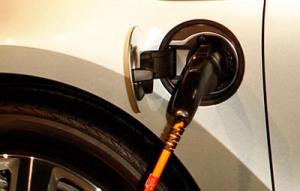EVs and the Smart Grid

A century or so ago, Thomas Edison’s commercialization of electricity unleashed an unprecedented cascade of change, altering the way humanity worked, lived and interacted. Today, with the convergent rise of the smart grid, renewable energy and electric vehicles (EVs), the power sector is embarking on a second era of transformation that promises to deliver a smarter, greener and more efficient 21st century.
Among utilities, this convergence requires them to recapitalize and expand the aging grid. Over the coming 20 years, anticipated investment in grid infrastructure will enable some $2 trillion in customer benefits, estimates the Electric Power Research Institute (EPRI). That represents a four- or five-fold return on the predicted cost of these upgrades, which EPRI figures will run upwards of $24 billion per year during that period. In the absence of these investments and the efficiency gains they promise, EPRI estimates that by mid century, the average electric bill could quadruple.
The weak links are the storage technology and grid management systems we’ll need to orchestrate the flow of electrons between tomorrow’s electric vehicles and a wider variety of clean and conventional power sources.
What’s more, customers are increasingly efficiency minded. The smart grid offers a more flexible way to satisfy these changing expectations. According to the 2011 IBM Global Utility Consumer Survey, 87 percent of respondents reported that they had taken at least one action to conserve energy.
Similarly, more than 90 percent of businesses and 70 percent of consumers have set specific goals to lower their electricity costs, according to a recent study cited by the New York Times. Additionally, nearly a third of companies have goals to self-generate electricity through solar panels, heat recovery and similar measures. The upshot, the study found, is that utilities could see as much as a 25 percent energy-cost reduction among business customers and increased frugality at the household level.
At a time when public discussion is focused on cost savings, investing in our national power infrastructure will do more than just help customers avoid higher utility bills. It will enable a switchover to cleaner, cheaper energy and speed the electrification of our transportation fleet. Indeed, over the past year, EVs have vaulted from promise to hot commodity. Persistent high-priced gas has attracted more drivers’ to the lower costs to recharge an EV.
The next generation battery could transform the dynamics of the grid, radically improving the performance of existing energy delivery infrastructure.
Yet to get the most from EVs, we need a smarter grid and better batteries. At night, when demand for electricity is low, the U.S. has around 250 GW of idle capacity. So if the nation’s 200 million cars and other light vehicles were electrified with the capacity to go a few hundred miles, nighttime recharging would demand about 230 GW.
A lack of electricity supply isn’t the roadblock to a transformation of our transportation system, or to greening the broader economy. Rather, the weak links are the storage technology and grid management systems we’ll need to orchestrate the flow of electrons between tomorrow’s electric vehicles and a wider variety of clean and conventional power sources.
Battery 500: Delivering the Long-Range EV
In energy circles, the quest for a better battery is reaching a fever pitch. Dozens of top labs around the world are chasing this goal, looking at a wide variety of technologies that aim to create a greater range for electric vehicles. The next generation battery could also transform the dynamics of the grid too, radically improving the performance of existing energy delivery infrastructure. They could also help solve the greatest problem facing solar panels and windmills: how to store and use renewable energy when the sun doesn’t shine or the wind doesn’t blow.
The Battery 500 team, an IBM-led industry and university collaboration, is working to develop battery technology that could potentially power a car 500 miles on a single charge with similar space requirements to traditional vehicles. Being able to travel this distance would help eliminate range anxiety, the concern of running out of power, and also reduce the need for constant charging throughout the day, thereby shifting recharging into the night when power is cheapest and capacity is most plentiful.
To achieve this, business as usual in battery energy storage won’t work and a new approach from today’s Lithium-ion batteries is needed. The team has already successfully tested a new type of Lithium-air battery technology that could improve energy density tenfold, dramatically increasing the amount of energy these batteries can store.
Most people consider switching to electric vehicles to save money on gas and contribute to a healthier environment. However, petrol has proven tough to replace. It is one of the most energy rich stores of energy commonly available. Yet gasoline is transformed into motion inefficiently in a car: on the average in the US, just 13 percent of the energy in gasoline makes it to the wheels. The rest is lost as heat, friction, exhaust and other pollution. Electric power trains are so much more efficient that 88 percent of the energy in the battery is translated into motion. This disparity means that while a tank of gas does contain a lot of energy, that energy is so wastefully harnessed that, some researchers predict, a standard sized Li-air battery could someday equal a gas tank’s usable energy content.
Business as usual in battery energy storage won’t work. A new approach from today’s Lithium-ion batteries is needed.
While the science behind building a 500-mile battery is challenging, the outcome of knowing we contributed to a healthier and smarter environment is worth the challenge. If these batteries can be manufactured in commercial volumes, researchers are hopeful we can start seeing them in cars by 2020.
Microgrids: Testing Tomorrow’s Smart Grid TodayIt took the better part of a century to build today's grid. And it will take years to upgrade it with storage, boost its intelligence, and improve its resiliency, all while adding renewable energy sources. Yet initial projects are already scaling up these changes to learn how to deploy them nationwide.
Consider microgrids. As the name suggests, microgrids are smaller—think corporate complex or academic campus. At these scales, the demand for power is large enough to justify more complex investments, such as on-site production and storage of electricity. But the scale is small enough to simplify experimentation that is still challenging on the broader public grid. For instance, a microgrid might mix together rooftop solar panels with small-scale wind turbines. And while storage devices remain rare on the wider grid, a microgrid can tap into conventional battery backup systems. Or emerging technologies such as flywheels or banks of super-capacitors, could be tested on a smaller, more-affordable scale.
Gluing together these parts is a Smart & Integrated MicroGrid Platform—SIMP. This acts like a conductor, orchestrating the flow of supply and demand of energy within the microgrid, as well as communicating with other microgrids and out into the public utility’s super-grid. Like a band leader, SIMP systems dispatch the right amount of resources at just the right time. Or they can trigger demand-reduction programs, just when needed. And in case of faults, the system might even trigger smart healing technologies that detect, route around and repair troubled links in the network.
In many ways, microgrid advances foreshadow the benefits promised by a smarter grid. Worries about the variability of renewables will no longer constrain their deployment, thanks to smart optimization of when and how those green electrons are stored and dispatched. The microgrid is quick to identify outages, as well, accelerating the dispatch repair crews and quickly finding ways to route around broken links. This enables utilities to more reliably manage energy within buildings, across the microgrid, and with outside suppliers.
A microgrid running more efficiently, able to accommodate more renewables, means not just greener power, but also a more reliable flow of energy—and ultimately, a lower cost of electricity.
EDISON: Real-world Test for Smart-Grid TechnologyMicrogrids offer a stepping stone to the greater rewards—and greater challenges—of rolling out the smart grid into larger, real-world markets.
Denmark is pioneering early efforts to do just that. A natural laboratory for energy technology innovation, Denmark draws about 20 percent of its electric power from renewables, mostly from advanced wind turbines. In time, its national goal is to boost that ratio to 40 percent. In fact, Denmark has already gone further in some regions. For instance, thanks to a mix of wind power, energy from agriculture waste and other renewables, the Danish island of Samsø became self-sufficient in electricity in 2002. At the same time, Denmark is a leader in electric vehicles, with a nationwide vision of using EVs for a tenth of its fleet. And on the island of Bornholm, its eastern-most major island, Denmark has a goal to see all the vehicles electrified. To meet that goal, a research consortium is focusing on Bornholm to model an advanced smart grid.
Microgrid advances foreshadow the benefits promised by a smarter grid. Worries about the variability of renewables will no longer constrain their deployment.
The project is known as EDISON, short for its full name: Electric Vehicles in a Distributed and Integrated Market using Sustainable Energy and Open Networks. IBM is teaming up with a host of Danish technology leaders, including DONG Energy, Technical University of Denmark, Eurisco, the Danish Energy Association and the regional energy company of Oestkraft, all supported with funding from Copenhagen. Germany’s Siemens, a leader in power generation, transmission and distribution technology, is also a key participant.
EDISON is developing systems that will enhance the use of renewable energy sources by tying them into EVs, and vice versa. When powered by electricity from clean energy, instead of fossil fuels, net emissions from EVs of greenhouse gases and other pollutants fall to near zero. Conversely, EVs can benefit renewables too. With their big banks of batteries, EVs could someday offer a mobile energy storage fleet, able to soak up excess output from wind and solar generation and to eventually return that energy to the grid during periods of peak demand.
Bornholm, home to 43,000, is an ideal stage to explore the potential of this technology. Dotted with more than 30 wind turbines, the island has enough clean energy capacity to meet about 40 percent of its electrical needs. Yet because the wind doesn’t always blow when power is needed, the turbines’ electricity output is sometimes turned down. As a result, just 20 percent of its actual electricity consumption comes from steady Baltic Sea winds.The EDISON team is exploring how battery storage could help the island use more of its renewable energy endowment. Researchers are modeling how the island’s electricity system evolves as the number of EVs connected to the grid grows. The goal is to synchronize the recharging of EVs so that they max out their recharge rate when strong winds are producing surplus power, but taper off the recharging process when the turbines slow and halt. EDISON is also looking at how, in times of slack winds, the process can be run in reverse, feeding power stored in the cars back onto the grid. For now, the studies are simulation-based so as not to risk the security of the island’s electricity supply.
When powered by electricity from clean energy, instead of fossil fuels, net emissions from EVs of greenhouse gases and other pollutants fall to near zero.
As utilities around the world race to install smart grid infrastructure, EDISON is breaking new ground by addressing the entire end-to-end process that will help improve overall grid stability and support the increased use of renewable energy. Once perfected, the technology being developed in Denmark will work just as well synchronizing the flow of solar power from California’s sun-soaked rooftops into its huge, fast-growing fleet of EVs.
“Electric vehicles are one of the technologies we can use to incorporate renewable energy into transportation,” said Connie Hedegaard, Danish Minister of Climate and Energy at the time of the project’s launch, and currently European Commissioner for Climate Change. “Projects like EDISON show how it's possible to create sustainable solutions in real life,” added Hedegaard.
The coming era of a more sustainable, smarter grid is just dawning. Unlike Thomas Edison’s time, the coming re-invention must roll-out in years, not decades. And big as this smart grid challenge is—the task certainly ranks among the largest transformation challenges ever—the speed of technology evolution is faster than ever before. What’s more, the urgency has never been greater.
Where Edison was motivated by opportunity, today’s smart grid inventors are driven by dire necessity too. Rising concern about the environment, dwindling supplies of affordable energy and materials and commitments to long-term economic growth dictate that we re-make the grid, sooner, better and faster than before.
ABOUT THE AUTHOR: Allan Schurr is vice president for energy and utilities at IBM and is focused on IBM’s market strategy, regulatory policy, and partner management for the global electric, gas, and water industries.




